Training your delts is a fundamental part of growing and defining your shoulders. Whether you are a training fanatic or designing your first training plan, the workouts below will help you meet your fitness goals.
standing behind neck press
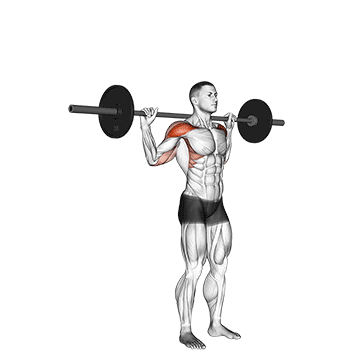
To perform the standing behind neck press, start by placing a barbell on a squat rack at about chest height. Stand facing the rack, your feet shoulder-width apart for stability.
Grasp the barbell with an overhand grip, hands slightly wider than shoulder-width apart. Lift the barbell off the rack and step back to clear the rack. Position the barbell behind your head, resting it on the muscles of your upper back, just below the base of your neck. This is your starting position.
Engage your core and keep your back straight. Press the barbell upwards until your arms are fully extended above your head. Ensure that you are pushing from your shoulders and not your back.
Pause for a moment at the top of the movement, then slowly lower the barbell back down to the starting position. Make sure to keep your movements controlled, don't let the weight drop quickly.
Repeat this movement for your desired number of repetitions. Remember to keep your core engaged and your back straight throughout the exercise to protect your spine.
This exercise targets the deltoid muscles in your shoulders. Be sure to use a weight that is challenging but allows you to maintain proper form. If you're new to this exercise, start with a lighter weight to get used to the movement.
landmine lateral raise
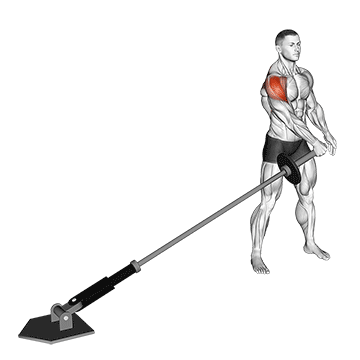
To perform the Landmine Lateral Raise, follow these steps:
1. Start by placing one end of a barbell into a landmine attachment. If you don't have a landmine attachment, you can place it in a corner of a room to keep it stable.
2. Stand sideways to the barbell, feet shoulder-width apart. Bend slightly at your knees and hips for stability.
3. Grab the free end of the barbell with your nearest hand. Your palm should be facing downwards.
4. Keep your arm slightly bent and raise the barbell up and out to your side until it's at shoulder height. Ensure your wrist, elbow, and shoulder are in a straight line.
5. Pause for a moment at the top of the movement, then slowly lower the barbell back down to the starting position.
6. Repeat the exercise for your desired number of repetitions. Once complete, switch sides and repeat the exercise with your other arm.
Remember to keep your core engaged throughout the exercise to maintain balance and stability. Also, avoid using your back or twisting your body to lift the weight; your shoulder should be doing the work.
ez barbell anti gravity press
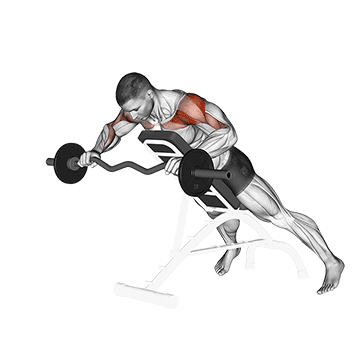
1. Start by standing upright with your feet shoulder-width apart. Hold the EZ barbell in front of you at shoulder height with an overhand grip. Your hands should be slightly wider than shoulder-width apart.
2. Engage your core and keep your back straight. This is your starting position.
3. Push the barbell straight up until your arms are fully extended above your head. Ensure that you are pushing the barbell upwards against gravity, hence the name 'anti gravity press'.
4. Pause for a moment at the top of the movement, then slowly lower the barbell back down to the starting position.
5. Make sure to keep your elbows slightly bent at the bottom of the movement to prevent strain.
6. Repeat this movement for the desired number of repetitions.
Remember to keep your movements controlled and steady, and avoid using your back or legs to help lift the barbell. The focus should be on your delts doing the work.
barbell wide-grip upright row
To perform the barbell wide-grip upright row, start by standing upright with your feet shoulder-width apart. Hold a barbell with an overhand grip, hands slightly wider than shoulder-width apart. This will be your starting position.
Ensure your back is straight, your chest is up, and your shoulders are relaxed. The barbell should be resting against the front of your thighs with your arms fully extended.
Begin the exercise by lifting the barbell straight up towards your chin, keeping it close to your body. Your elbows should drive the motion, and should always be higher than your forearms. Continue to lift the barbell until it nearly touches your chin.
Pause for a moment at the top of the movement, then slowly lower the barbell back to the starting position. This completes one repetition.
Remember to keep your torso stationary and your back straight throughout the exercise. The movement should be performed with your shoulders and arms, not with your body.
Perform this exercise for the recommended number of repetitions. If you're new to this exercise, start with a lighter weight to ensure you can perform the movement correctly and safely. As you get stronger, you can gradually increase the weight.
barbell upright row v. 3
To perform the Barbell Upright Row v. 3, start by standing upright with your feet shoulder-width apart. Hold a barbell in front of your body with an overhand grip, hands slightly less than shoulder-width apart.
Ensure your arms are fully extended with elbows slightly bent. This is your starting position. Keep your back straight and your chest up throughout the exercise.
Begin the movement by lifting the barbell straight up towards your chin, leading with your elbows. Keep the barbell as close to your body as possible. Continue to lift until the barbell is nearly touching your chin and your elbows are at shoulder height or slightly above.
Pause for a moment at the top of the movement, then slowly lower the barbell back to the starting position. This completes one repetition.
Remember to keep your core engaged and avoid using your back or legs to lift the weight. The movement should be controlled, with the focus on your delts doing the work.
Perform the desired number of repetitions and sets for your workout. As with any exercise, start with a lighter weight to perfect your form before moving on to heavier weights.
barbell upright row v. 2
To perform the barbell upright row v. 2, start by standing upright with your feet shoulder-width apart. Hold the barbell in front of your body with an overhand grip, hands slightly less than shoulder-width apart.
Ensure your arms are fully extended with elbows slightly bent. This is your starting position.
Next, exhale and use your side shoulders to lift the bar, raising your elbows up and to the side. Keep the bar close to your body as you raise it. Continue to lift the bar until it nearly touches your chin.
Hold the contraction at the top for a second, then slowly lower the bar back down to the starting position while inhaling.
Ensure that your torso remains stationary throughout the movement and that the lift is performed only with the side deltoids and the arms.
Repeat this movement for the recommended amount of repetitions.
Remember to always use a weight that's suitable for your fitness level. It's important to maintain proper form throughout the exercise to avoid injury.
barbell upright row
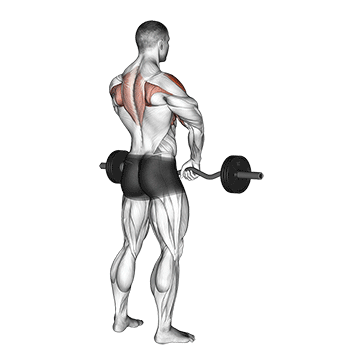
To perform the barbell upright row, start by standing straight with your feet shoulder-width apart. Hold the barbell in front of your body with an overhand grip, hands slightly less than shoulder-width apart.
Ensure your arms are fully extended with elbows slightly bent. This is your starting position.
Now, exhale and use the sides of your shoulders to lift the bar, raising your elbows up and to the side. Keep the bar close to your body as you raise it. Continue to lift the bar until it nearly touches your chin.
Be sure to keep your torso stationary and your elbows raised higher than your forearms. At the top of the movement, hold for a brief pause, then inhale and slowly lower the barbell back to the starting position.
Remember to keep your back straight and your movements controlled throughout the exercise. Avoid using your biceps or back muscles to lift the barbell; the focus should be on your delts.
Repeat for the recommended amount of repetitions. If you're new to this exercise, start with a lighter weight to ensure you're using the correct form and gradually increase the weight as you get stronger.
barbell thruster
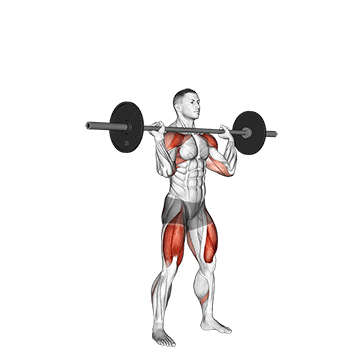
To perform the barbell thruster, start by positioning yourself in front of a barbell. Stand with your feet shoulder-width apart, toes slightly pointed outwards.
Bend down and grip the barbell with an overhand grip, hands slightly wider than shoulder-width apart. Clean the barbell to your shoulders by explosively standing up, shrugging your shoulders, and then bending your knees slightly to catch the barbell at shoulder height. This is your starting position.
Next, lower your body into a full squat position while keeping the barbell at shoulder level. Your thighs should be parallel to the floor, and your elbows should be pointing forward.
Push through your heels to stand up out of the squat. As you reach the top of the squat, use the momentum to press the barbell overhead until your arms are fully extended.
Lower the barbell back to your shoulders while simultaneously bending your knees to enter the next squat. This completes one rep.
Remember to keep your core engaged and your back straight throughout the exercise. Repeat for the desired number of repetitions.
The barbell thruster is a compound exercise that targets your delts, but also works your legs, core, and upper body. Always use a weight that is challenging but allows you to maintain proper form.
barbell standing wide military press
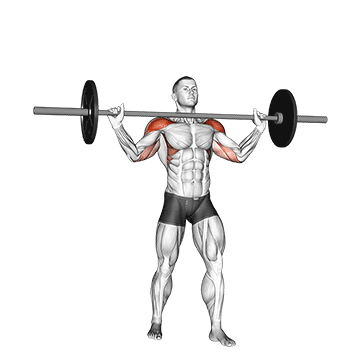
To perform the barbell standing wide military press, start by loading the barbell with the desired weight. Ensure the weight is balanced on both sides.
1. Stand upright and position your feet shoulder-width apart for stability.
2. Reach out and grab the barbell with a wide grip, hands wider than shoulder-width apart. The palms of your hands should be facing forward.
3. Lift the barbell off the rack or from the floor and hold it at shoulder level. This is your starting position.
4. Brace your core and press the barbell straight up until your arms are fully extended. Keep your back straight and avoid leaning back as you press the weight up.
5. Pause for a moment at the top, then slowly lower the barbell back to the starting position at shoulder level.
6. Repeat the movement for the desired number of repetitions.
Remember to keep your body stable throughout the exercise and avoid using your back or legs to help lift the weight. The focus should be on your delts doing the work. Always use a weight that is challenging but allows you to maintain good form.
barbell standing front raise over head
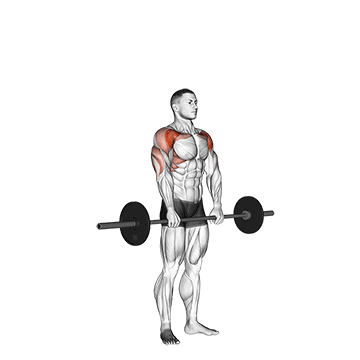
1. Start by selecting a barbell with an appropriate weight that you can comfortably lift.
2. Stand upright with your feet shoulder-width apart. Hold the barbell with an overhand grip, hands shoulder-width apart, and let it hang in front of your thighs. This is your starting position.
3. Keeping your back straight and your core engaged, slowly lift the barbell up in front of you. Keep your arms extended and your elbows slightly bent to avoid any strain.
4. Continue to raise the barbell until it is at shoulder height. Make sure to keep your body still, only your arms should be moving.
5. From this position, continue to lift the barbell overhead until your arms are fully extended.
6. Pause for a moment at the top of the movement, then slowly lower the barbell back down to shoulder height.
7. Continue to lower the barbell back down to the starting position in front of your thighs.
8. Repeat this movement for your desired number of repetitions.
Remember to keep your movements controlled, don't use momentum to lift the barbell. This exercise should be done slowly and deliberately for the best results.
barbell standing close grip military press
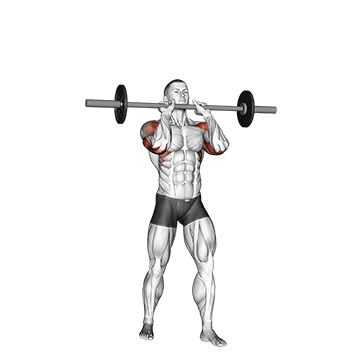
1. Start by placing a barbell that is about chest high on a squat rack. Make sure it's at a height that's comfortable for you to reach.
2. Stand facing the barbell with your feet shoulder-width apart for stability.
3. Grip the barbell with your palms facing forward and your hands closer than shoulder-width apart. This is your starting position.
4. Lift the barbell off the rack and position it at shoulder level. Keep your elbows close to your body and your torso straight.
5. Exhale and push the barbell upward until your arms are fully extended above your head. Keep your back and head straight throughout the movement.
6. Pause for a moment at the top of the movement, then slowly lower the barbell back to the starting position while inhaling.
7. Repeat this movement for the desired number of repetitions.
8. When you're done, carefully re-rack the barbell.
Remember to keep your core engaged throughout the exercise to protect your lower back. Also, avoid using your legs or back to help lift the weight; your shoulders and arms should be doing the work.
barbell standing bradford press
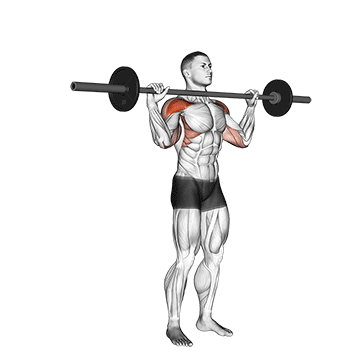
To perform the Barbell Standing Bradford Press, follow these steps:
1. Stand upright with your feet shoulder-width apart.
2. Hold the barbell with an overhand grip, hands slightly wider than shoulder-width apart.
3. Start with the barbell resting on your upper chest, just below your chin. This is your starting position.
4. Push the barbell straight up until your arms are almost fully extended.
5. Instead of locking out your arms at the top, lower the barbell behind your head until it touches the base of your neck.
6. Push the barbell back up to the top position, then lower it down to the front of your body, returning to the starting position.
7. This completes one rep.
Remember to keep your core engaged and your back straight throughout the exercise. The movement should be controlled, avoiding any jerky motions. Start with a lighter weight to ensure you can perform the exercise with proper form, then gradually increase the weight as your strength improves. This exercise primarily targets the deltoid muscles in your shoulders.
barbell skier
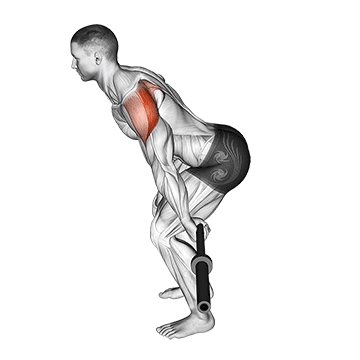
To perform the Barbell Skier exercise, follow these steps:
1. Stand upright with your feet shoulder-width apart. Hold a barbell with both hands, palms facing towards you. The barbell should be hanging at arm's length in front of your thighs.
2. Bend at your hips and knees slightly, keeping your back straight. This is your starting position.
3. Keeping your arms straight, lift the barbell up and out to your sides until they're at shoulder level. Your body should form a T shape. Ensure your torso remains stationary and only your arms are moving. This movement should mimic the motion of a skier pushing off with their poles.
4. Hold this position for a second, then slowly lower the barbell back to the starting position.
5. Repeat this movement for the desired number of repetitions.
Remember to keep your movements controlled and steady, and avoid using your back or swinging the barbell to lift it. This exercise primarily targets your deltoid muscles, but also works your upper back and core. Always use a weight that is challenging but allows you to maintain proper form.
barbell seated overhead press
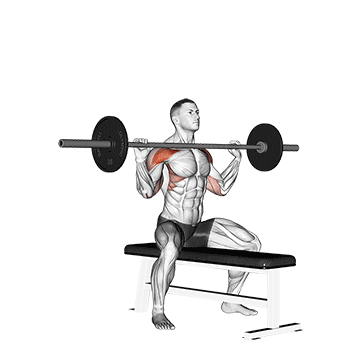
To perform the barbell seated overhead press, start by sitting on a bench with a back support. Place your feet firmly on the ground, shoulder-width apart.
Pick up the barbell with an overhand grip, hands slightly wider than shoulder-width apart. Lift the barbell to shoulder height, keeping your elbows bent and your palms facing forward. This is your starting position.
Engage your core and keep your back straight. Press the barbell upwards until your arms are fully extended above your head. Ensure that you do not lock your elbows at the top of the movement.
Pause for a moment at the top, then slowly lower the barbell back to the starting position. Make sure to keep your back straight and your core engaged throughout the movement.
Repeat this movement for your desired number of repetitions. Remember to breathe in as you lower the barbell and breathe out as you press it upwards.
This exercise primarily targets your deltoid muscles, but also works your triceps and upper back. Always ensure to use a weight that is challenging but allows you to maintain proper form.
barbell seated bradford rocky press
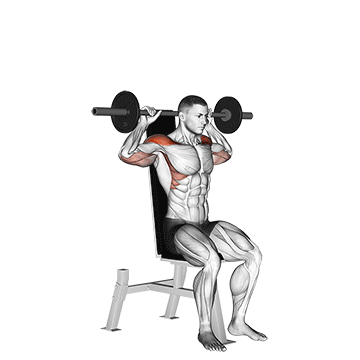
1. Start by sitting on a flat bench with a barbell rack. Make sure your feet are flat on the floor and your back is straight.
2. Grab the barbell with a wider than shoulder-width grip. Lift the barbell off the rack and hold it at shoulder level. This is your starting position.
3. Push the barbell straight up until your arms are fully extended, but don't lock your elbows.
4. Lower the barbell behind your head until it reaches the base of your neck. Keep your elbows stationary and close to your head.
5. Push the barbell back up to the starting position, then lower it in front of your body to your chest.
6. Push the barbell back up to the starting position. This completes one rep.
7. Repeat for the desired number of reps.
Remember to keep your core engaged throughout the exercise to maintain balance and stability. Also, ensure that the weight you're using is manageable to avoid straining your neck or shoulders.
barbell seated behind head military press
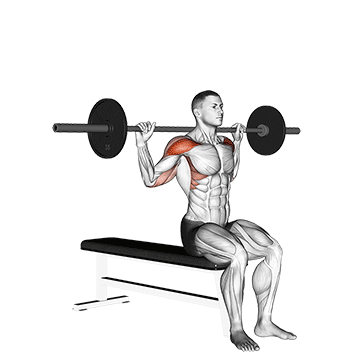
1. Start by sitting on a bench with a back support, ensuring your feet are flat on the floor for stability.
2. Grab a barbell with an overhand grip, hands slightly wider than shoulder-width apart.
3. Carefully lift the barbell over your head until your arms are fully extended. This is your starting position.
4. Slowly lower the barbell down behind your head until your elbows form a 90-degree angle. Ensure you keep your back straight and your elbows close to your head throughout the movement.
5. Push the barbell back up to the starting position, fully extending your arms but not locking your elbows.
6. Repeat this movement for your desired number of repetitions.
Remember to always use a weight that is challenging but allows you to maintain proper form. It's also important to engage your core throughout the exercise to protect your lower back.
barbell rear delt row
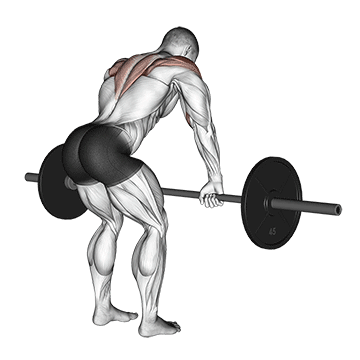
1. Start by standing upright with your feet shoulder-width apart. Hold a barbell with an overhand grip, hands slightly wider than shoulder-width apart.
2. Bend your knees slightly and hinge forward from your hips, keeping your back straight. Your torso should be almost parallel to the floor. The barbell should hang directly in front of your knees.
3. Pull the barbell up towards your chest, keeping your elbows flared out to the sides. Ensure that you are pulling with your rear deltoids and not your back.
4. Pause for a moment at the top of the movement, squeezing your shoulder blades together.
5. Slowly lower the barbell back down to the starting position, fully extending your arms and feeling a stretch in your deltoids.
6. Repeat for the desired number of reps.
Remember to keep your core engaged throughout the exercise to maintain balance and stability. Also, avoid rounding your back or using your lower back to lift the weight. The focus should be on your rear deltoids.
barbell rear delt raise
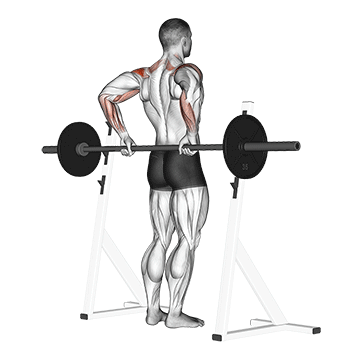
To perform the barbell rear delt raise, start by standing upright with your feet shoulder-width apart. Hold a barbell with both hands using an overhand grip, ensuring your hands are also shoulder-width apart.
Bend your knees slightly and lean forward from your waist until your torso is almost parallel to the floor. The barbell should hang directly in front of you with your arms fully extended and perpendicular to the floor. This is your starting position.
Keeping your torso stationary, lift the barbell to your side in a semicircular motion while keeping your arms slightly bent at the elbows. Continue to lift the barbell until your arms are parallel to the floor. Ensure you squeeze your shoulder blades together at the top of the movement.
Pause for a moment at the top of the movement, then slowly lower the barbell back to the starting position in a controlled manner.
Remember to keep your back straight and your movements smooth throughout the exercise. Avoid using your back or legs to lift the barbell; your shoulders should do all the work.
Repeat for the recommended amount of repetitions.
This exercise primarily targets the rear deltoids, but also works the upper back and traps. Always use a weight that is challenging but allows you to maintain proper form.
barbell one arm snatch
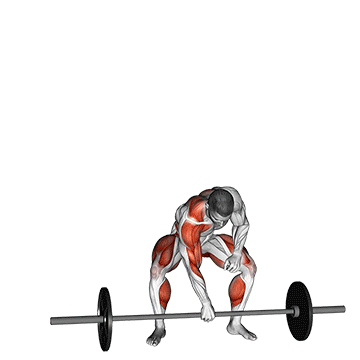
1. Start by standing upright with your feet shoulder-width apart. Place a barbell on the floor in front of you.
2. Bend at your hips and knees to lower your body until you're able to grasp the barbell with one hand. Your palm should be facing towards you. This is your starting position.
3. In a swift and controlled motion, lift the barbell off the floor by powerfully extending your hips and knees. As the barbell rises to your waist level, pull it up by raising your elbow until it reaches shoulder height.
4. As the barbell continues to rise, drop your body underneath it by bending your knees and hips. Catch the barbell overhead with your arm fully extended. Your palm should be facing forward and your wrist should be directly above your shoulder.
5. Stand up straight, keeping the barbell overhead. This completes one rep.
6. Lower the barbell back to the floor in a controlled manner and repeat the movement for your desired number of repetitions.
7. Once you've completed your set, switch to the other arm and repeat the process.
Remember to keep your back straight and core engaged throughout the exercise. Also, ensure that the weight you're lifting is manageable to avoid injury. This exercise should be performed under the guidance of a fitness professional, especially for beginners.
barbell front raise
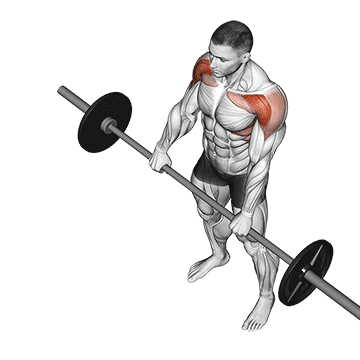
To perform the barbell front raise, start by standing straight with your feet shoulder-width apart. Hold a barbell at thigh level with your palms facing down towards your body. This is your starting position.
Engage your core and keep your back straight throughout the exercise. Begin by slowly raising the barbell up in front of you. Keep your arms extended and elbows slightly bent to avoid any strain. Continue to lift the barbell until it is at shoulder height and parallel to the floor.
Ensure that you are lifting the barbell with your delts and not using your back or momentum to raise the weight. Your body should remain stationary, with only your arms moving.
Hold this position for a second, then slowly lower the barbell back down to the starting position. This completes one repetition.
Remember to breathe in as you lift the barbell and breathe out as you lower it. Aim for 3 sets of 10-12 repetitions, ensuring to maintain proper form throughout.
Always use a weight that is challenging but allows you to complete the exercise with correct form. If you feel any discomfort or pain, stop the exercise immediately and consult with a fitness professional.
No tags for this post.
